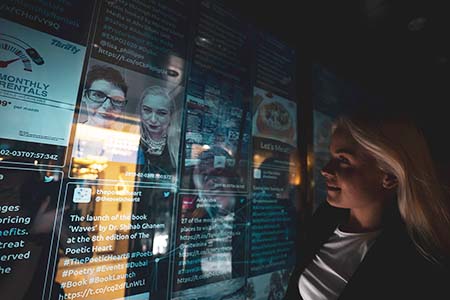Twitter's #ElevatorTweets campaign is designed to attract UAE businesses to KSA audiences; compelling neuro-science findings also help solidify Twitter's position in Saudi Arabia

Twitter unveiled a regional-first campaign in Dubai today with #ElevatorTweets, where entrants into one of the lifts/elevators at the Dubai Properties Group building in Media City could see curated, real-time conversations of whats happening in Saudi Arabia displayed on a large LED screen fitted on one wall of the lift. Interestingly, the tweets were tailored based on the floors to which people were going.
The activated lift utilised state-of-the-art technology to create an interactive experience of rich media and video, which appears on the walls of the lift. Upon entering the lift, pressure pad sensors placed on the lift buttons trigger signals to temporarily-coated walls of screen mirrors, initiating the Tweets wall. Every office floor opens the doors to a map of whats happening in Saudi Arabia relevant to the business of the organisation. For example, through a specific hashtag, employees of an automotive company will be shown everything they need to know about the industry and competition in Saudi Arabia, while an agency representing a travel operator will find the latest news about the industry in the market and so on.
Speaking about the initiative, Carla El Maalouli, Head of Business Marketing, MENA, Twitter said: Twitters strength is conversation, and our most valuable asset is our audiences. Our audiences actively listen and openly connect, they are not on the platform to passively scroll through, they are there to passionately engage. Through the innovation of #ElevatorTweets, we are connecting businesses with their most valuable audiences when theyre most receptive. The activation demonstrates the power of Twitter through the push of a button, focusing on the people at the heart of conversations.
Twitter will move the wall to other lifts weekly as part of the campaign.
Twitter also used the opportunity to share the results of its research study in Saudi Arabia, conducted by UK-based neuro-marketing company, Neuro-Insight. The first-of-its-kind study looked at the consumption of content on different, leading social media platforms, unlocking insights into the variations of Saudi users receptivity to content in different mobile environments.
Neuro-Insight outfitted users with specially designed visors and headsets, complete with sensors. This state-of-the-art kit then measured the tiny electrical pulses in the brain as people used Twitter and other social media platforms.
Commenting on the study, Walid Issa, Head of Research, MENA, Twitter, said: We opted for neuro research in an effort to move beyond claimed responses to a survey; to access what really happens at a subconscious level. Through our recent study with Neuro-Insight, we unlocked the variation of receptivity of users based in Saudi Arabia. The research confirmed the belief that social media platforms are used by people for different purposes, while confirming that for Twitter, our audiences truly are immersed, leaned-in and highly engaged with the content they consume on the platform.
The survey confirmed that Twitter users do not use the social platform to communicate with friends and family as much as it does to gather information, breaking news and find out more about topics that are of interest to them. The environment demands a higher attentiveness and translates into a more receptive audience.
The findings claimed that Twitter is the only platform where people view ads in a positive manner because they are not compelled to watch it by being interrupted by ads while consuming content on the platform; consequently, they do not react negatively to ads.
Although some of the other platforms elicited stronger levels of memory encoding than Twitter, the ads were being encoded alongside a negative emotional response. This is primarily due to the visual attention being high, but the overall ad experience being quite jarring, leading to a high level of withdrawal.
Long-term memory encoding measures whats being encoded into long-term memory as people are exposed to a stimulus. Left brain memory is responsible for processing detail, written and spoken words. Approach/Withdrawal indicates the polarity of an emotional response. Approach is the brain metaphorically wanting to move towards something, whereas withdrawal is the brain wanting to take a step back.
















































































